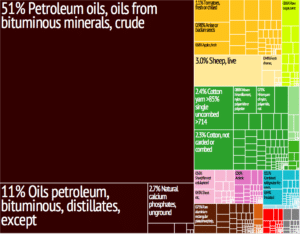According to various sources, including the United Nations, up to 100,000 people had been killed by June 2013, including 11,000 children. To escape the violence, 4.9 million Syrian refugees have fled to neighboring countries of Jordan, Iraq, Lebanon, and Turkey. An estimated 450,000 Syrian Christians have fled their homes. By October 2017, an estimated 400,000 people had been killed in the war according to the UN.
Geography:
The country consists mostly of arid plateau, although the northwest part bordering the Mediterranean is fairly green. Al-Jazira in the northeast and Hawran in the south are important agricultural areas. The Euphrates, Syria’s most important river, crosses the country in the east. Syria is one of the fifteen states that comprise the so-called “cradle of civilization“. Its land straddles the “northwest of the Arabian plate“.

Petroleum in commercial quantities was first discovered in the northeast in 1956. The most important oil fields are those of Suwaydiyah, Qaratshui, Rumayian, and Tayyem, near Dayr az–Zawr. The fields are a natural extension of the Iraqi fields of Mosul and Kirkuk. Petroleum became Syria’s leading natural resource and chief export after 1974. Natural gas was discovered at the field of Jbessa in 1940.
Economy:
As of 2015, the Syrian economy relies upon inherently unreliable revenue sources such as dwindling customs and income taxes which are heavily bolstered by lines of credit from Iran. Iran is believed to spend between $6 billion and US$20 billion a year on Syria during the Syrian Civil War. The Syrian economy has contracted 60% and the Syrian pound has lost 80% of its value, with the economy becoming part state-owned and part war economy. At the outset of the ongoing Syrian Civil War, Syria was classified by the World Bank as a “lower middle income country.” In 2010, Syria remained dependent on the oil and agriculture sectors. The oil sector provided about 40% of export earnings. Proven offshore expeditions have indicated that large sums of oil exist on the Mediterranean Sea floor between Syria and Cyprus. The agriculture sector contributes to about 20% of GDP and 20% of employment. Oil reserves are expected to decrease in the coming years and Syria has already become a net oil importer. Since the civil war began, the economy shrank by 35%, and the Syrian pound has fallen to one-sixth of its prewar value. The government increasingly relies on credit from Iran, Russia and China.

The economy is highly regulated by the government, which has increased subsidies and tightened trade controls to assuage protesters and protect foreign currency reserves. Long-run economic constraints include foreign trade barriers, declining oil production, high unemployment, rising budget deficits, and increasing pressure on water supplies caused by heavy use in agriculture, rapid population growth, industrial expansion, and water pollution. The UNDP announced in 2005 that 30% of the Syrian population lives in poverty and 11.4% live below the subsistence level.
Syria’s share in global exports has eroded gradually since 2001. Unemployment is high at above 10%. Poverty rates have increased from 11% in 2004 to 12.3% in 2007. In 2007, Syria’s main exports include crude oil, refined products, raw cotton, clothing, fruits, and grains. The bulk of Syrian imports are raw materials essential for industry, vehicles, agricultural equipment, and heavy machinery. Earnings from oil exports as well as remittances from Syrian workers are the government’s most important sources of foreign exchange.
